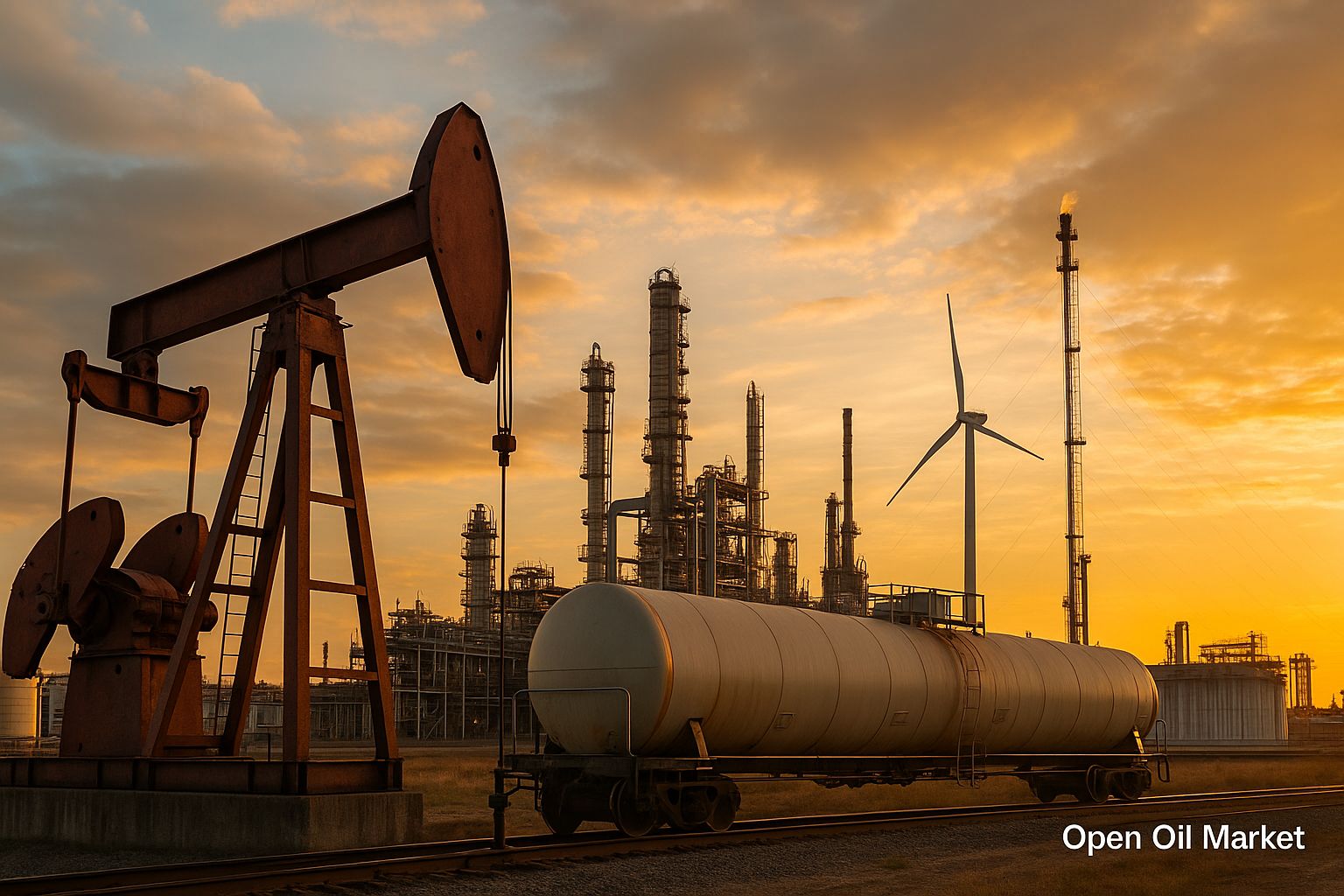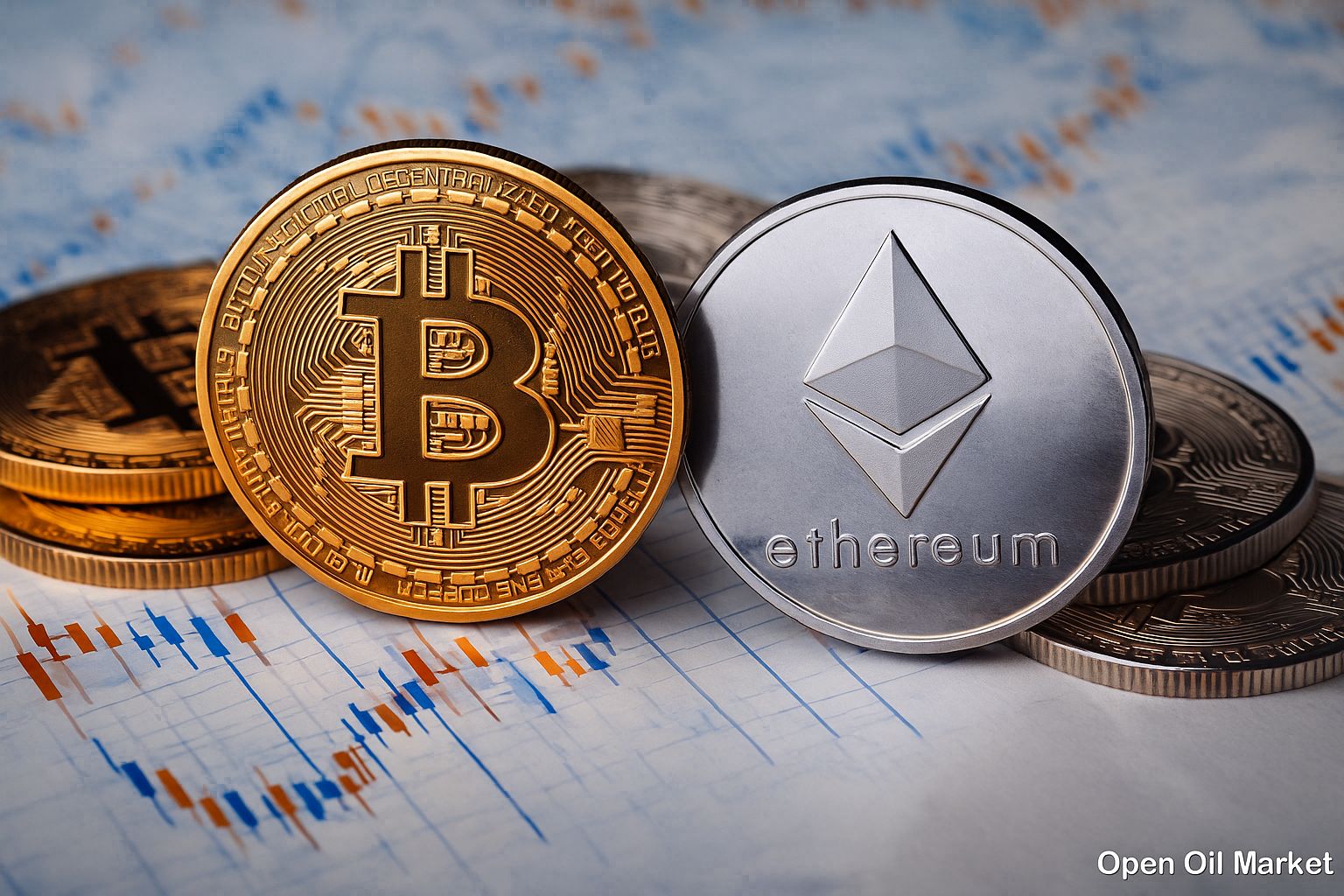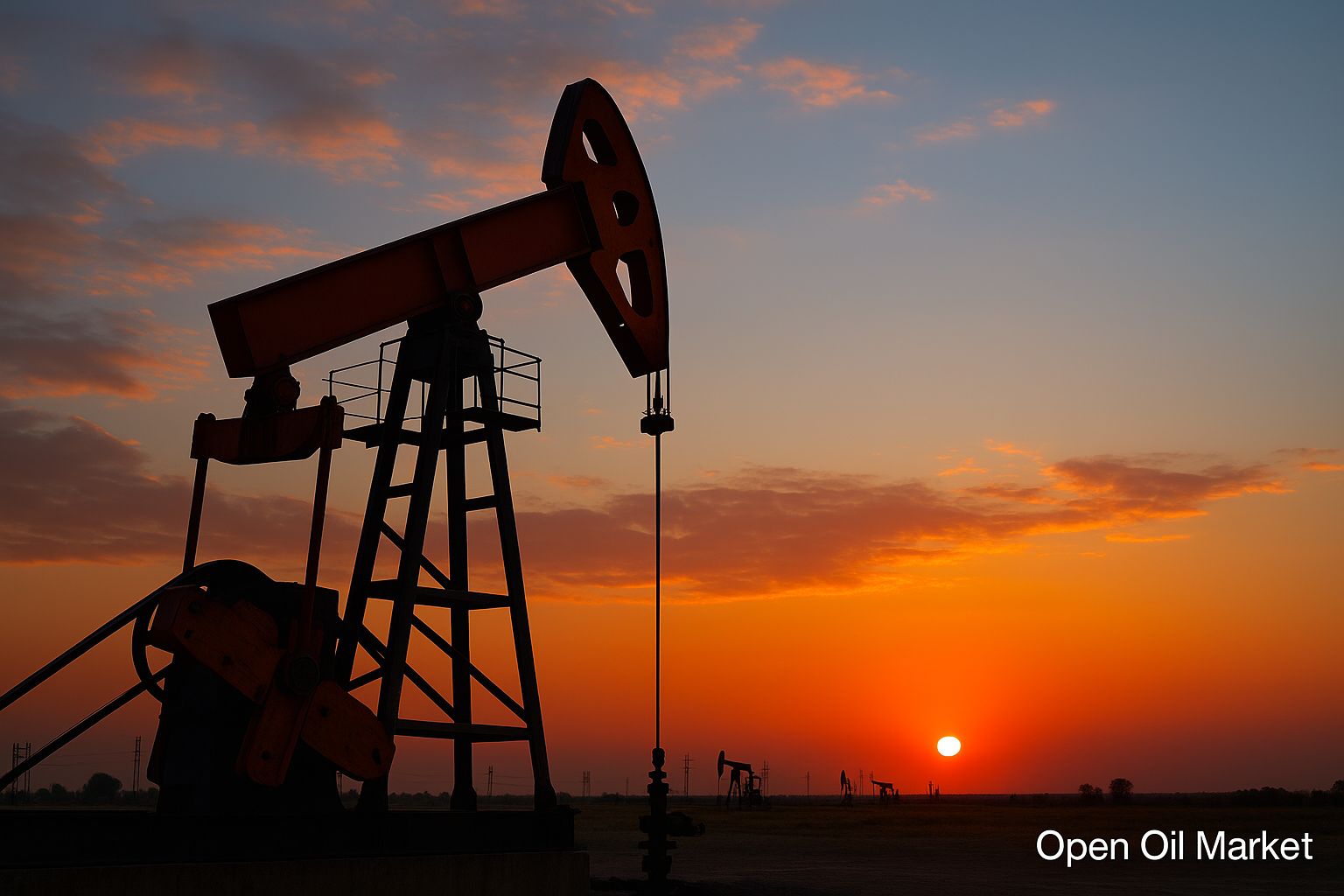
Global Energy Market News as of 15 October 2025: Stabilisation of the Fuel Market in Russia, Pressure on Oil Prices, Record Gas Reserves, Record Investments in Renewable Energy, and the Launch of Russian Energy Week. Analysis from Open Oil Market.
In mid-October, global commodity markets are relatively calm despite a range of opposing factors. Oil prices remain under pressure due to expectations of oversupply by year-end, while the European gas market enters winter with record reserves, ensuring a buffer. Simultaneously, a key industry forum — Russian Energy Week — has commenced in Moscow, where strategic issues concerning the fuel and energy complex are being discussed. Western sanctions against the Russian energy sector continue to create tension, but the industry is adapting to the new conditions. Below is an overview of current events in the fuel and energy sector that are important for investors, market participants, oil and gas companies.
Stabilisation of the Fuel Market in Russia: Government Measures and Initial Results
Following the acute fuel crisis in September, the situation in the domestic oil products market is gradually normalising. In most regions of Russia, the gasoline deficit has been eliminated, wholesale prices have retreated from peak values, and independent fuel stations are resuming continuous fuel sales. However, areas distant from major oil refineries still experience supply tensions — authorities continue to maintain control of the situation by extending restrictions and implementing new market support mechanisms.
- Emergency Measures and Imports: The government has extended the ban on gasoline exports until 31 December 2025, as well as maintained restrictions on diesel fuel exports for independent suppliers until the end of the year. These steps aim to saturate the domestic market as much as possible. Concurrently, avenues for attracting external resources are being explored; a temporary nullification of import duties is being discussed to simplify the import of gasoline and diesel (for instance, from Belarusian refineries) to meet the needs of remote regions.
- Price Dampeners and Control: From 1 October, a moratorium on the zeroing of fuel dampers has been introduced — the government continues to compensate refiners for supplies to the domestic market, even if domestic wholesale prices exceed threshold levels. This measure preserves the economic incentive to direct gasoline and diesel to filling stations within the country. Simultaneously, the Federal Antimonopoly Service and the Ministry of Energy have tightened price monitoring: several petrol stations have received warnings for unjustified price increases. Some market participants propose establishing official limits on retail prices at petrol stations; however, the government is currently avoiding direct state regulation, opting instead for market mechanisms and targeted support measures.
- Initial Outcomes: By mid-October, the motor fuel deficit has significantly reduced. The completion of unscheduled repairs at refineries and the redirection of export volumes to the domestic market have allowed for increased wholesale shipments to affected regions. In central and southern areas, gasoline and diesel stocks at bases and petrol stations are returning to normal levels. The government hopes to navigate the winter period without acute supply disruptions, although the situation requires constant monitoring and readiness for additional interventions.
Commentary. The government's actions to stabilise the market were timely and necessary, notes Sergey Tereshkin, CEO of the fuel marketplace Open Oil Market. According to him, maintaining dampening payments amid high prices and restricting exports have helped saturate the domestic market and alleviate the crisis. In the future, alongside manual regulation, the industry requires systematic development of infrastructure, including the implementation of digital platforms for wholesale oil product trading, to increase transparency in fuel distribution across regions and prevent similar situations from recurring.
Oil Market: Oversupply, Price Risks, and Sanction Factors
The global oil market in the second half of October is displaying a moderately declining price trend. The Brent crude benchmark has stabilised in a range of approximately $62–64 per barrel, while American crude WTI is trading at $58–60. This is significantly lower than this year's peaks (around $80) and reflects expectations of surplus supply by the end of 2025. OPEC+ countries are adhering to the decision to gradually increase production: from November, the total quota will rise by approximately +137,000 bpd, continuing the trend of steadily regaining market shares. At the same time, demand is growing weaker than anticipated, adding pressure to prices.
- Slowdown in Demand: The International Energy Agency (IEA) downgraded the forecast for global oil demand growth in 2025 to approximately 710,000 barrels per day (previously anticipated at +740,000). This is significantly lower than in previous years, amid an economic slowdown in Europe and China. OPEC also projects modest demand growth (approximately +1.2 million bpd), while non-OPEC production (primarily in the U.S.) is growing at a faster pace. As a result, analysts warn of the potential for an oil surplus in the global market in the fourth quarter, which keeps prices under pressure.
- Sanctions and Geopolitics: Sanction pressure remains a significant factor for the oil sector. Mid-year saw the implementation of a reduced price cap on Russian oil to $47.6 per barrel (18th package of EU sanctions), and Western countries are discussing further restrictions on energy exports from Russia. Washington is urging allies to strive for a complete embargo on Russian oil and to curb sanctions evasion through a "shadow fleet" of tankers. These efforts carry risks for global oil trade: any tightening of sanctions could reduce available supply and trigger a new wave of price volatility, especially if coinciding with other risk factors.
- New Markets: Despite sanctions, Russia has retained its main export volumes, redirecting supplies from Europe to Asia. India and China have increased purchases of Russian oil at discounted prices – traders estimate that up to 30% of India's oil imports are provided by Russian barrels. The flow of supplies is also increasing to Turkey, the Middle East, and Africa. This reorientation supports the revenues of the Russian energy sector and balances the global market, although it requires significant discounts and complicates logistics. In the event of further sanctions reinforcement (for example, the introduction of secondary measures against carriers or buyers), this channel may narrow, posing a new challenge for Russian oil companies.
Natural Gas: European Reserves, Abandonment of Russian Gas, and Eastern Reorientation
The situation in the global natural gas market in October is favourable for consumers. The European Union enters the heating season with record reserves: underground gas storage (UGS) facilities in EU countries are filled to over 95% of maximum capacity — significantly above last autumn's levels. Thanks to mild weather and an increase in liquefied natural gas (LNG) imports, Europe has created a safety cushion ahead of a potentially cold winter. Wholesale gas prices at the TTF hub remain at relatively low levels (around €30–35/MWh), significantly lower than the peaks of 2022. The market remains stable, as demand this autumn is currently moderate.
- Complete Abandonment of Russian Gas: European countries continue their course to rapidly reduce dependence on Russian gas. Direct pipeline supplies from Russia have dropped to minimal levels and are only sustained by a few nations (e.g., Hungary) under historical contracts. Moreover, the European Commission is preparing the 19th sanctions package, proposing to legally consolidate a phased abandonment of Russian LNG by 2026–2027. Already, the share of Russian gas in the EU's imports has decreased from approximately 40% to less than 15% over the past two years, and it is anticipated that purchases from Russia will be reduced to zero in the coming years.
- Redirection of Supplies Eastward: In response to the loss of the European market, Russia is increasing gas exports towards Asia. Supplies through the 'Power of Siberia' pipeline to China are expected to reach record levels by 2025 — exceeding 22 billion cubic meters per year, approaching design capacity. Additionally, the construction of a second pipeline to China via Mongolia ('Power of Siberia 2') is being discussed, which will partially compensate for the loss of the European market by the end of the decade. Furthermore, Russia is expanding LNG sales to Asia: new projects in Yamal and the Far East are boosting supplies of liquefied gas to India, China, Bangladesh, and other countries. Despite these steps, in the short term, total Russian gas exports will remain below pre-sanction levels — ensuring the domestic market and partnerships within the CIS remain a priority.
Electric Power: Record Consumption and Network Modernisation
Global electricity consumption continues to reach historic highs in 2025. Economic growth, the development of digital technologies, and the electrification of transport are driving increased demand for electricity across all regions. Industry forecasts indicate that total global electricity generation this year will exceed 30,000 TWh for the first time — an unprecedented level. The largest economies are contributing significantly: the U.S. is expected to consume approximately 4.1 trillion kWh (a new record for the country), while China will exceed 8.5 trillion kWh. Energy consumption is also rapidly growing in developing countries across Asia, Africa, and the Middle East, supported by industrialisation and population growth.
- Network Strain: The rapid increase in electricity consumption requires proactive modernisation of energy infrastructure. Many countries have announced large-scale investment programmes to expand and update networks and construct new generating capacities. The aim is to prevent energy shortages and outages during peak loads. For example, in the U.S., companies are investing billions of dollars to bolster distribution networks in response to increasing demands from data centres and charging stations for electric vehicles. Similar projects aimed at strengthening energy systems are being implemented in Europe, China, and India. Moreover, the role of intelligent 'smart' grids and energy storage systems is increasing, helping to manage load flexibly and integrate the growing generation from renewable sources.
Renewable Energy: Record Investments, Support, and New Challenges
The renewable energy sector in 2025 is showing impressive growth, continuing the global trend towards the 'green' transformation of the energy sector. Investments in solar and wind energy, as well as related clean technologies, are setting records. In the first six months of 2025 alone, approximately $400 billion has been invested globally in renewable energy projects — 10–12% more than the same period last year. These funds are primarily directed towards the construction of new solar and wind power plants, as well as the creation of energy storage infrastructure (industrial batteries) and the digitalisation of grids to integrate distributed generation. Thanks to the commissioning of new capacities, electricity production is increasing without a rise in greenhouse gas emissions.
Statistics confirm this progress: analysts estimate that in the first half of 2025, around 380 GW of solar power capacity was installed globally — almost 1.7 times more than the previous year. Significant contributions to this growth came from megaprojects in China, India, the Middle East, and the U.S. Wind power capacity is also increasing rapidly: new offshore wind farms in the North Sea (EU), off the coast of China, and Southeast Asia are collectively adding tens of gigawatts to the global energy balance.
- Share of Clean Energy: Renewable sources are occupying an increasingly significant place in the global energy balance. On average, about 30% of electricity generation worldwide is now ensured by renewable energy. In the EU, this figure has exceeded 45%, buoyed by active climate policies and the phasing out of coal-fired power plants. China is nearing the 30% mark for generation from renewables, despite the massive scale of its energy system and ongoing construction of new coal plants. For the first time in 2025, global electricity generation from solar and wind surpassed coal production — an important symbolic milestone for the energy sector.
- Government Support and Initiatives: The governments of major economies are intensifying support for 'green' energy. In Europe, new climate goals have been adopted, necessitating an accelerated introduction of clean capacities and the development of carbon trading. In the U.S., measures to stimulate renewable energy and related industries continue (tax incentives and subsidies under the Inflation Reduction Act, IRA). Similar initiatives are also underway in CIS countries: Russia and Kazakhstan are holding DPM renewable energy competitions to select solar and wind projects, while Uzbekistan is constructing large solar parks in desert regions. Such support aims to reduce sector costs and attract new investments, accelerating the transition to clean energy.
- Growth Difficulties: The rapid development of renewable energy is accompanied by several challenges. High demand for equipment and raw materials (such as polysilicon for solar panels) leads to project cost increases and pressure on supply chains. The sector also faces a shortage of qualified personnel for the construction and operation of hundreds of new facilities worldwide. Moreover, energy systems are encountering the necessity to maintain flexibility: integrating a large volume of variable generation requires the accelerated development of energy storage systems and intelligent load management. Despite these challenges, the global course towards decarbonisation remains intact — experts predict further growth in investments in renewable energy and record increases in the share of clean energy.
Coal Market: Asian Demand and Gradual Phase-Out of Coal
The global coal market in 2025 is characterised by mixed trends. In several Asian countries, demand for coal remains high, occasionally even intensifying. During the summer, a spike in energy coal imports was recorded in East Asia: for instance, in August, China, Japan, and South Korea collectively increased purchases by nearly 20% compared to the previous month. Domestic factors played a role: in China, due to intensified environmental checks and safety requirements, coal production was temporarily reduced, while industrial energy consumption was rapidly growing. China compensated for the shortfall in generation through additional coal imports, which raised regional prices: Australian coal of the Newcastle brand rose above $110 per tonne (the highest in the last 5 months). Similarly, India and other developing economies have increased coal combustion to sustain stability in their energy systems.
At the same time, the long-term outlook for the coal industry remains unfavourable. An increasing number of states are adhering to a policy of phasing out coal for environmental goals and reducing emissions. The share of coal generation in the EU has dropped below 10% (a few years ago it was around 15%), and 11 EU countries intend to fully close all coal power plants by 2030, replacing them with gas and renewable capacities. In the U.S., despite targeted initiatives to support coal, market conditions are similarly unfavourable for coal: cheap natural gas and the rapid expansion of renewables are displacing coal from the energy mix. Even countries traditionally dependent on coal are reducing usage — for example, Germany, after temporarily increasing coal combustion in 2022–2023, reduced coal-fired electricity generation again in 2025.
- Reorientation of Exports from Russia: For Russia, one of the largest coal exporters, global trends signify a shift in primary markets. Following the EU embargos imposed in 2022, Russian coal companies have redirected supplies to Asia. Currently, more than 75% of Russian coal exports are destined for China, India, Turkey, and other countries in the Asia-Pacific region. This demand partially offsets the loss of the European market, although sales to distant countries require discounts and elevate logistics costs. In the long term, as the world’s leading economies increasingly abandon coal, Russian coal producers will need to adapt — developing new markets and enhancing efficiency to maintain competitiveness.
Forecasts and Expectations: Forum in Moscow and the Winter Season
The beginning of Q4 2025 presents mixed expectations for the industry. On one hand, the measures undertaken for stabilisation inspire cautious optimism: the Russian fuel market is emerging from the crisis due to government actions, and global oil and gas prices are being kept under control through OPEC+ efforts and record reserves. On the other hand, ahead lies the winter season and ongoing geopolitical tensions — factors that could provoke new fluctuations in the markets. Unpredictable weather conditions or a sudden tightening of sanctions could once again destabilise the balance of supply and demand.
Russian Energy Week, which opened on 15 October in Moscow under the theme "Creating the Energy of the Future Together", has become a platform to discuss these challenges and opportunities. It is expected that new agreements and partnerships aimed at the development of the fuel and energy complex and strengthening international cooperation will be reached at the forum. The outcomes of the meeting among industry leaders will set the tone for further reforms and investments. Overall, investors and participants in the energy sector are concluding the year with guarded optimism — adaptation to new conditions continues, and the energy sector is demonstrating resilience and readiness for change.




